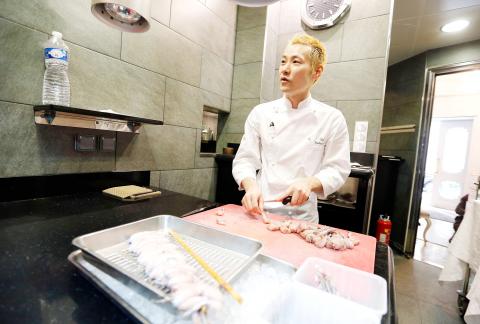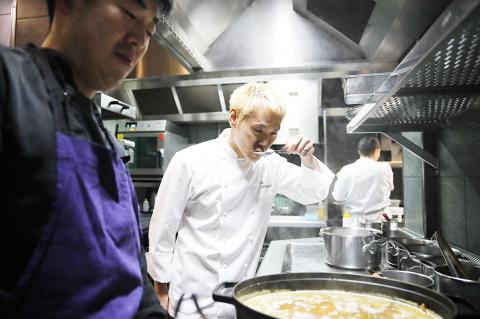Chef Kei Kobayashi is speaking his mind — something he says it took moving to France to learn.
Less than 24 hours after he became the first ever Japanese cook to win the maximum three Michelin stars in France, the phones are ringing off the hook at his Paris restaurant, Kei.
The last of the lunchtime diners are skipping out of his minimalist dining room not far from the Louvre, grinning from ear to ear.

Photo: AFP
They have just eaten a piece of history, and at 58 euros (US$63) for a set lunch, a bargain into the bag.
Kobayashi is holding forth in his clinically clean kitchen as his small team scurry around him.
“Japanese people are usually very quiet. But you cannot survive in France like that,” he said.

Photo: AP
The dozen or so other Japanese chefs who have been making waves in the rarefied world of French haute cuisine over the last few years are usually meekness incarnate.
They bow, say a few humble halting words of thanks and are off.
Not Kobayashi. The first thing that the 42-year-old said after getting his third star was how difficult and demanding he was.
With his gelled bleached blond hair, there is something of the showman about the young blade who readily admits to driving his cooks ferociously hard.
But it was not always so, he insisted, claiming France has changed him.
‘I SAY WHAT I MEAN’
“I am direct now. Like the French, I say what I mean,” he said.
“I am a very difficult guy,” he added, as he barked out an order in his small but perfectly designed kitchen. “Working with me means lots of stress. I watch and check everything.”
“Compared to a French chef” — who are not renowned for being touchy-feely — “I am probably more difficult,” he smiled.
But Kobayashi was careful not to ruffle feathers when asked if he and other young Japanese were beating the French at their own game and in their own back garden.
“France has accepted us and given us a place, so I thank France,” he said, adding that the Japanese cooks have been trained in the French tradition for nearly 150 years.
And indeed, it was watching a documentary about the nouvelle cuisine pioneer Alain Chapel that inspired Kobayashi to follow his father — a chef specialising in traditional Japanese kaiseki cuisine — into the kitchen.
Like his compatriot Yosuke Suga — who topped the La Liste’s ranking of the world’s best restaurants this year with his tiny Tokyo table, Sugalab, and who is only a few months his senior — Kobayashi decided to learn at the feet of his French heroes.
While some French gastronomes have implied that Kobayashi’s restaurant was not quite grand enough for the culinary holy grail of three stars, even the Michelin guide’s worst enemy believes its inspectors got it right.
French chef Marc Veyrat, who lost his third star last year and took Michelin to court in the notorious “Cheddargate” case, tipped his toque to him.
CRITICS ‘TRANSPORTED’
“I say ‘Bravo!’,” Veyrat said. “It’s great that people like him are coming here.”
Kobayashi, who was born in Nagano, opened his Paris restaurant nine years ago with his wife Chikako after working under a series of legendary French three-star chefs including Alain Ducasse, one of his mentors.
His pastry chef Toshiya Takatsuka — who has also been making a name for himself in France — said he decided to move to Paris to work under Kobayashi after eating at Kei in 2013.
“I could immediately feel the spirit of the chef, the concentration — everything was so absolutely right,” he said.
Working with him, however, is no bed of roses, he admitted.
“He puts you under the maximum pressure. He always tells the truth, he never hides things. He says what he thinks — there is no filter,” 35-year-old Takatsuka added.
“But I think he is harder on himself than he is on others... He has thought everything through in the restaurant, as he keeps saying, it’s a theater.”
And its star is Kobayashi’s cooking, with the dining room’s sparse grey interior designed to point up his startling creations like his “Garden of crunchy vegetables” which transported the Michelin inspectors.
When asked why there were no pictures on the walls, he replied, “My cuisine provides the necessary colour.” As Kobayashi mixes the salad of up to 40 ingredients covered in a citrus mousse, “in which every spoonful has a different taste,” it’s hard to disagree.

Most heroes are remembered for the battles they fought. Taiwan’s Black Bat Squadron is remembered for flying into Chinese airspace 838 times between 1953 and 1967, and for the 148 men whose sacrifice bought the intelligence that kept Taiwan secure. Two-thirds of the squadron died carrying out missions most people wouldn’t learn about for another 40 years. The squadron lost 15 aircraft and 148 crew members over those 14 years, making it the deadliest unit in Taiwan’s military history by casualty rate. They flew at night, often at low altitudes, straight into some of the most heavily defended airspace in Asia.

Taiwan’s democracy is at risk. Be very alarmed. This is not a drill. The current constitutional crisis progressed slowly, then suddenly. Political tensions, partisan hostility and emotions are all running high right when cool heads and calm negotiation are most needed. Oxford defines brinkmanship as: “The art or practice of pursuing a dangerous policy to the limits of safety before stopping, especially in politics.” It says the term comes from a quote from a 1956 Cold War interview with then-American Secretary of State John Foster Dulles, when he said: ‘The ability to get to the verge without getting into the war is

Like much in the world today, theater has experienced major disruptions over the six years since COVID-19. The pandemic, the war in Ukraine and social media have created a new normal of geopolitical and information uncertainty, and the performing arts are not immune to these effects. “Ten years ago people wanted to come to the theater to engage with important issues, but now the Internet allows them to engage with those issues powerfully and immediately,” said Faith Tan, programming director of the Esplanade in Singapore, speaking last week in Japan. “One reaction to unpredictability has been a renewed emphasis on

Beijing’s ironic, abusive tantrums aimed at Japan since Japanese Prime Minister Sanae Takaichi publicly stated that a Taiwan contingency would be an existential crisis for Japan, have revealed for all the world to see that the People’s Republic of China (PRC) lusts after Okinawa. We all owe Takaichi a debt of thanks for getting the PRC to make that public. The PRC and its netizens, taking their cue from the Chinese Communist Party (CCP), are presenting Okinawa by mirroring the claims about Taiwan. Official PRC propaganda organs began to wax lyrical about Okinawa’s “unsettled status” beginning last month. A Global